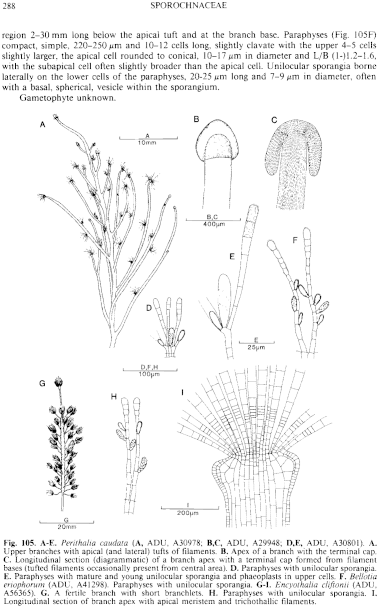|
|
|
|
|
|||||||||||
|
Electronic Flora of South Australia Species Fact Sheet
Phylum Phaeophyta – Order Sporochnales
Selected citations: Lucas 1936:99, fig. 55. Womersley 1967: 238.
Thallus (Fig. 104C) medium to dark brown, (10–) 20–100 cm long, with a single percurrent axis developing radially long lateral branches fringed with numerous, short, slender branchlets (Fig. 105G) 5–15 mm long, 1–3 mm apart, borne at right angles, each with a prominent apical tuft of assimilatory filaments; attachment by a rhizoidal holdfast 2–12 mm across and 2–7 mm long; epilithic. Growth (Fig. 1051) apical, with a convex branch meristem (usually with slight shoulders) surmounted by a dense tuft of trichothallic filaments 2–7 mm long, with similar tufts at the apex of each branchlet, each filament with a meristem 5–8 cells above the base, 30–40 µm in diameter above with cells L/B 2–3. Fronds terete, with a robust axis 1.5–2 (–3) mm in diameter below and usually becoming stupose or felt-like with rhizoids, decreasing to 0.5–1 mm in diameter above and in the 10–20 cm long laterals, apices often becoming frayed, with the slender branchlets 150–200 µm in diameter. Structure haplostichous and pseudoparenchymatous, with a medulla of elongate cells and the single-layered cortex becoming multi-layered in the axis and laterals by periclinal divisions, with the surface cells (5–) 7–9 across and L/B (1.2–) 1.5–2 (–2.5).
Reproduction: Sporangial sori surrounding the lateral branches or the upper axis for lengths of 4–10 cm, including the base of the slender, sterile, branchlets, 1–1.5 (–2) mm in diameter. Paraphyses (Fig. 105H) compact, simple, 200–240 µm and 10–15 cells long, clavate with the upper 2–3 cells larger, 12–14 µm in diameter, with the apical cell ovoid to slightly conical, L/B 1.2–1.5. Unilocular sporangia borne laterally on the central cells of the paraphyses, 25–30 (–40) µm long and 7–9 µm in diameter.
Gametophyte unknown.
Type from Fremantle, W. Aust.; in Herb. Harvey, TCD.
Selected specimens: Red Bluff, Kalbarri, W. Aust., 6–10 m deep (Kraft & Ricker, 15.xii.1980; MELU, A35091). 7 mile beach, Dongara, W. Aust., 1–2 m deep (Kirkman, 17.ix.1979; ADU, A51315). Flinders Bay, W. Aust., drift (Wollaston, 12.ii.1957; ADU, A22140). Pearson I., S. Aust., 12 m deep (Turner, 27.iii.1982; ADU, A53053). Point Avoid, Eyre Pen., S. Aust., drift (Womersley, 2.xii.1975; ADU, A46855). Off Troubridge Light, S. Aust., 17 m deep (Shepherd, 4.ii.1969; ADU, A33421). Tiparra Reef, S. Aust., 11 m deep (Shepherd, 24.ii.1971; ADU, A38132). Port Stanvac, S. Aust., 6 m deep (Clarke, 29.xii.1977; ADU, A50401). Stanley Beach, S. coast Kangaroo I., S. Aust., drift ( Womersley, 4.ii.1957; ADU, A20965). Victor Harbor, S. Aust., drift (Womersley, 11.ii.1985; ADU, A56365-"Marine Algae of southern Australia" No. 260). Walkerville, Vic., drift (Sinkora A1530, 9.iii.1 972; ADU, A42285).
Distribution: From Kalbarri, W. Aust. to Guichen Bay, S. Aust. and Walkerville, Vic.
Taxonomic notes: E. cliftonii is an elegant, deep water, species (5–17 m deep), often common from Western Australia to Victor Harbor, S. Aust., with records also from Guichen Bay, S. Aust., and Walkerville, Vic., but not from Tasmania.
References:
HARVEY, W.H. (1859a). Phycologia Australica. Vol. 2, Plates 61–120. (Reeve: London.)
LUCAS, A.H.S. (1936). The Seaweeds of South Australia. Part 1. Introduction and the Green and Brown Seaweeds. (Govt Printer: Adelaide.)
WOMERSLEY, H.B.S. (1967). A critical survey of the marine algae of southern Australia. II. Phaeophyta. Aust. J. Bot. 15, 189–270.
The Marine Benthic Flora of Southern Australia Part II complete list of references.
Publication:
Womersley, H.B.S. (14 December, 1987)
The Marine Benthic Flora of Southern Australia
Part II
©Board of the Botanic Gardens and State Herbarium, Government of South Australia
Illustrations in Womersley Part II, 1997: FIGS 104C, 105 G–I.

Figure 104 enlarge
Fig. 104. A. Perithalia caudata (ADU, A27072). B. Bellotia eriophorum (ADU, A41298). C. Encyothalia cliftonii (ADU, A46855).

Figure 105 enlarge
Fig. 105. A–E. Perithalia caudata (A, ADU, A30978; B,C, ADU, A29948; D,E, ADU, A30801). A. Upper branches with apical (and lateral) tufts of filaments. B. Apex of a branch with the terminal cap. C. Longitudinal section (diagrammatic) of a branch apex with a terminal cap formed from filament bases (tufted filaments occasionally present from central area). D. Paraphyses with unilocular sporangia. E. Paraphyses with mature and young unilocular sporangia and phaeoplasts in upper cells. F. Bellotia eriophorum (ADU, A41298). Paraphyses with unilocular sporangia. G–I. Encyothalia cliftonii (ADU, A56365). G. A fertile branch with short branchlets. H. Paraphyses with unilocular sporangia. I. Longitudinal section of branch apex with apical meristem and trichothallic filaments.

|
Email Contact: State Herbarium of South Australia |

|